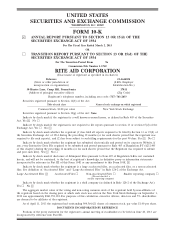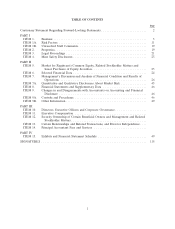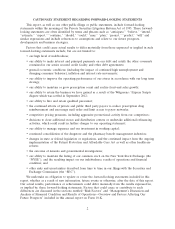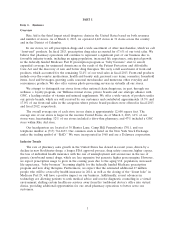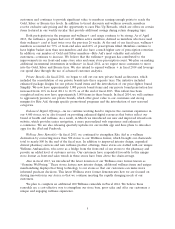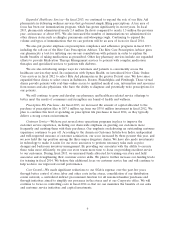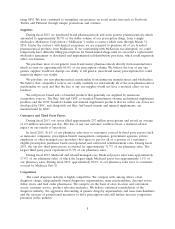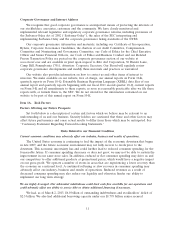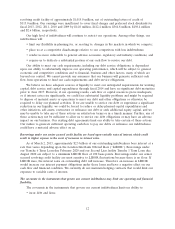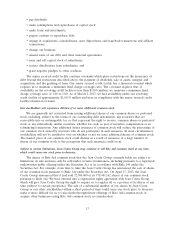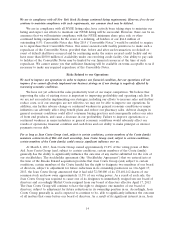Rite Aid 2013 Annual Report Download - page 5
Download and view the complete annual report
Please find page 5 of the 2013 Rite Aid annual report below. You can navigate through the pages in the report by either clicking on the pages listed below, or by using the keyword search tool below to find specific information within the annual report.Generic prescription drugs help lower overall costs for customers and third party payors. We
believe the utilization of existing generic pharmaceuticals will continue to increase. A significant
number of new generics became available during 2012, which contributed to our substantially improved
fiscal 2013 results. Generic introductions are expected to slow down for fiscal 2014, with the next
significant wave of generic introductions coming in fiscal 2015 as additional popular branded drugs are
scheduled to lose patent protection. The gross profit from a generic drug prescription in the retail
drugstore industry is generally greater than the gross profit from a brand drug prescription. However,
the sale amount can be substantially less.
The retail drugstore industry is highly competitive and has been experiencing consolidation. We
believe that the continued consolidation of the drugstore industry, continued new store openings,
increased competition from internet and mail order based providers and aggressive generic pricing
programs at competitors such as Wal-Mart and various supermarket chains will further increase
competitive pressures in the industry. The pharmacy business has continued to be highly promotional,
which contributes to additional competitive pressures.
The retail drugstore industry relies significantly on third party payors. Third party payors, including
the Medicare Part D plans and the state sponsored Medicaid and related managed care Medicaid
agencies, at times change the eligibility requirements of participants or reduce certain reimbursement
rates. These changes and reductions are expected to continue. When third party payors, including the
Medicare Part D program and state sponsored Medicaid agencies, reduce the number of participants
and/or reduce their reimbursement rates, sales and margins in the industry could be reduced, and
profitability of the industry adversely affected. These possible adverse effects can be partially or entirely
offset by lowering our product cost, controlling expenses, dispensing more higher margin generics and
dispensing more prescriptions overall.
Strategy
Our strategy for fiscal 2014 is to continue the transformation of Rite Aid into a neighborhood
destination for health and wellness. This strategic objective will not only allow us to better meet the
needs of our customers and patients in a rapidly changing healthcare environment, but will also help us
to continue the positive financial momentum we have generated over the past several years.
Financially, our primary goal for fiscal 2014, consistent with fiscal 2013, is to continue growing
same stores sales while expanding EBITDA margins, both of which are critical to achieving long-term
financial success. By growing same-store sales, we can take full advantage of our recent cost control
improvements as well as margin benefits resulting from the wave of new generic medications
introduced in fiscal 2013.
In order to drive our financial performance and sustainable sales growth, we will continue to
increase the level of capital investment in our store base through initiatives such as the Wellness store
remodel program and prescription file purchases. We will also continue to build upon key initiatives we
have introduced in recent years such as our highly successful wellness+ customer loyalty program and
expanded pharmacy services, including immunizations. At the same time, we will focus on developing
new programs that meet the evolving needs of our customers as we enter a period of rapid change in
the U.S. healthcare industry. We expect that these continued investments and our focus on key
initiatives will generate long-term value for our shareholders.
Below are descriptions of our key initiatives:
wellness+—Since its launch in April of 2010, our free wellness+ program has provided customers
and patients with the opportunity to earn significant discounts and wellness rewards in return for being
loyal Rite Aid shoppers. Enrolled members earn rewards based on the accumulation of points for
certain front-end and prescription purchases. The program has been well received by Rite Aid
4

